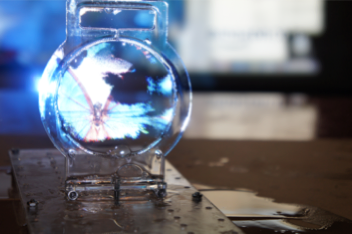
A Colloidal Display: membrane screen that combines transparency, BRDF and 3D volume
The Colloidal Display proposes an innovative solution which transforms a soap film into the world’s thinnest screen. This screen’s transparency, texture, and shape can be controlled dynamically by using ultrasonic sound waves. The screen’s unique material, which allows objects to pass through, promotes new ways of interaction.
Yoichi Ochiai, Alexis Oyama and Keisuke Toyoshima, A Colloidal Display: membrane screen that combines transparency, BRDF and 3D volume, ACM SIGGRAPH 2012 Emerging Technologies, Poster, Talks (in publish)
The Colloidal Display proposes an innovative solution which transforms a soap film into the world’s thinnest screen. This screen’s transparency, texture, and shape can be controlled dynamically by using ultrasonic sound waves. The screen’s unique material, which allows objects to pass through, promotes new ways of interaction.
It is a common knowledge that the surface of soap bubble is a micro membrane. It allows light to pass through and displays the color on its structure. We developed an ultra thin and flexible BRDF screen using the mixture of two colloidal liquids. There have been several researches on dynamic BRDF display[1] in the past. However, our work is different in several points. Our membrane screen can be controlled using ultrasonic vibrations. Membrane can change its transparency and surface states depending on the scales of ultrasonic waves. Based on these facts, we developed several ap- plications of the membranes such as 3D volume screen.
The combination of the ultrasonic waves and ultra thin membranes makes more realistic, distinctive, and vivid imageries on screen. This system contributes to open up a new path for display engineering with sharp imageries, transparency, BRDF and flexibility.
Yoichi Ochiai, Alexis Oyama, Keisuke Toyoshima
A Colloidal Display: membrane screen that combines transparency, BRDF and 3D volume